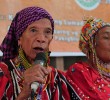The violence in Sulu the past weeks, which was punctuated by the series of bombings in three key cities on Feb. 14, indicate that the objectives of the 1996 peace agreement are far from achieved.
By Carlos H. Conde
Bulatlat.com
MANILA � Nearly a decade ago, the Philippine government and the Moro National Liberation Front (MNLF), the first Moro separatist group, signed a peace agreement that many thought would end the 27-year Islamic rebellion in the southern Philippines.
But the violence there the past two weeks, which was punctuated by the series of bombings in three key cities on Feb. 14, indicate that the objectives of that supposed political settlement are far from achieved.
�It is not a stretch to say that the outbreak of terrorism in the Philippines can be traced directly to the failure of the 1996 peace agreement with the Moro National Liberation Front,� said Abhoud Syed Lingga, a Moro scholar and expert on the Islamic separatist movement in Mindanao.
As a result of the failure of the 1996 peace agreement between the government and the moderate MNLF to end the conflict in Mindanao, other groups grew. These are the Moro Islamic Liberation Front (MILF) � which had broken away from the MNLF earlier – and the Abu Sayyaf, a group that originally espoused Islamic fundamentalism but degenerated into kidnapping, rape and murder, and is now trying to return to its fundamentalist roots, terrorism experts say, by establishing alliances with domestic Islamic groups as well as the Jemaah Islamiyah.
People were euphoric after the signing of the agreement, which established the Autonomous Region in Muslim Mindanao (ARMM). Millions of dollars in aid from the West poured into Mindanao, where most of the country�s Moros live. As part of the agreement, the armed forces absorbed former guerrillas of the MNLF. Livelihood projects, many of them funded and supported by the United Nations and Western nongovernment organizations, were established.
The government insists that the agreement produced some significant gains, such as the Moros� integration into the political and economic mainstream, representation in government, establishment of their own educational system and the integration by the former guerrillas into the military.
Slow implementation
But over all, the implementation of the agreement has been slow, the results modest at best.� �There have been problems, true, but despite these problems, the process has been holding,� said Teresita Deles, an adviser to President Gloria Macapagal-Arroyo on the peace process.
�People should also keep in mind that, since 1996, there has not been open hostilities between the MNLF and the government,� she added.
Whether Moros actually benefited from these gains is another story, said Soliman Santos, another expert on Islamic separatism.
The Moro region was still the poorest in the country, the literacy rate hardly improved, the infant mortality rate was still the highest compared to the other regions, lawlessness was still rampant. Tens of thousands of Moros were displaced in the ongoing conflicts.
Before long, Moros started to look to the MILF, which by then was offering the very thing that the government and the MNLF had said they had delivered: self-rule for Moros.
The Washington-based U.S. Institute of Peace, which has been involved in the peace process on behalf of the U.S. government, recognized early on the difficulties that lie ahead.� �The long history of the conflict and the failed approaches to resolve it have created deep divisions among Moros and among the general Filipino populace, which regards any peace agreements with skepticism or, at the most, guarded optimism,� it said in a recent report.
The ARMM, the region that the MNLF has been tasked to manage, was not exactly autonomous. It is hamstrung by a number of factors, among them the fact that it still depends on Manila for its budget and that it cannot exploit its natural resources that easily and on its own because it would violate the constitution.
Land redistribution
The agreement also did not tackle land redistribution, a contentious issue for the Moros here whose lands were confiscated by Christians, often by force, after World War II.
�Nearly all agree today that this experiment in autonomy has been a failure, both due to the Philippine government�s insincerity and the fundamental limitations of a constitutional approach,� wrote Shauna Morgan of the University of Toronto, who studied the agreement.
�Instead of self-rule, what the MNLF got was integration into the very system that they had fought,� said Lingga, the Moro scholar. �It was a fatal mistake for the MNLF.�
For years, Nur Misuari, the founding chairman of the MNLF, served as governor of the region but he hardly performed, according to his critics. Worse, he was hounded by allegations of corruption and incompetence that eventually led to his ouster from the leadership of the MNLF.
Misuari broke away from the Arroyo administration when it refused to support him for reelection as governor in 2001. But a more fundamental reason for this falling out, some of his friends say, was Misuari�s disaffection, which he didn�t hide from the public, toward the peace agreement.
�They promised Misuari autonomy but they wanted merely to pacify him. They were just trying to solve the problem of the MNLF, as if the MNLF was the problem,� Lingga said, referring to then President Fidel Ramos and the Organization of Islamic Conference, which brokered the peace process. Lingga said Ramos railroaded the agreement no matter what so that he can have a legacy of this presidency. The OIC pressured Misuari into signing it because it wanted a showcase for the international Islamic community.
Meanwhile, violence continues in the south, with Misuari�s loyalists battling government troops in Jolo and, according to the military, maintaining alliances with the Abu Sayyaf.
Denial
The leader of the MNLF uprising in Sulu has denied any involvement with the Abu Sayyaf. Ustadz Habier Malik, a well-respected and well-liked MNLF leader, has said in previous statements that his group�s assault on government positions beginning on Feb. 7 was in retaliation for the military�s killing of civilians, including a child and a pregnant woman, a week before.
But the military has been insisting that three of the victims were Abu Sayyaf members. It has, however, failed to rebut allegations that its offensives in Sulu against the Abu Sayyaf have victimized civilians, particularly children.
The MILF, which is negotiating with the government, is now in the best position to correct the wrongs of the 1996 agreement, said Santos, who wrote a book about the separatist struggle here.
�The framework should be to solve the fundamental problem, which is the lack of self-rule for Moros,� Santos said. �If you can achieve that key aspiration, you�re on your way to solving the conflict in Mindanao.�
That, too, will deal with the problem of Islamic extremism and terrorism. In a report last July, the Brussels-based International Crisis Group said that “genuine and fully implemented autonomy for Philippine Muslims is a sine qua non in winning the long-term war on terror in Mindanao.� (Bulatlat.com)










